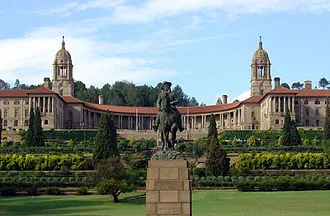Job vacancies in the government of South Africa
 |
| Union Building |
Government publishes a vacancy circular every week and if you are interested in working for the government you are in the right place.
Click here to navigate available jobs and apply.
About the government of South Africa
The Republic of South Africa is a parliamentary republic
with a three-tier system of government and an independent judiciary, operating
in a parliamentary system. Legislative authority is held by the Parliament of
South Africa.
South Africa's government differs greatly from those of
other Commonwealth nations. The national, provincial, and local levels of
government all have legislative and executive authority in their own spheres, and are defined in the South African Constitution as "distinctive,
interdependent, and interrelated".
Legislature
The Parliament of the Republic of South Africa is South Africa's legislature; under the present Constitution of South Africa, the bicameral Parliament comprises a National Assembly and a National Council of Provinces. The current twenty-seventh Parliament was first convened on 22 May 2019. From 1910 to 1994, members of Parliament were elected chiefly by the South African white minority. The first elections with universal suffrage were held in 1994. Both chambers held their meetings in the Houses of Parliament, Cape Town which was built 1875–1884. A fire broke out within the buildings in early January 2022, destroying the session room of the National Assembly. The National Assembly will temporarily meet at the Good Hope Chamber.
Executive
The President, Deputy President, and Ministers make up the executive branch of the national government. Ministers are Members of Parliament who are appointed by the President to head the various departments of the national government. The president is elected by parliament from its members.
Judicial
The third branch of the national government is an independent judiciary. The judicial branch interprets the laws, using as a basis the laws as enacted and explanatory statements made in the Legislature during the enactment. The legal system is based on Roman-Dutch law and English common law and accepts compulsory ICJ jurisdiction, with reservations. The constitution's bill of rights provides for due process including the right to a fair, public trial within a reasonable time.
Provincial government
The nine provinces of South Africa are governed by provincial governments which form the second layer of government, between the national government and the municipalities. The provincial governments are established, and their structure is defined, by Chapter Six of the Constitution of South Africa.
The provincial governments are structured according to a parliamentary system in which the executive is dependent on and accountable to the legislature. In each province, the provincial legislature is directly elected by proportional representation, and the legislature in turn elects one of its members as Premier to head the executive. The Premier appoints an Executive Council (a cabinet), consisting of members of the legislature, to administer the various departments of the provincial administration.
The powers of the provincial governments are circumscribed by the national constitution, which limits them to certain listed "functional areas". In some areas, the provincial government’s powers are concurrent with those of the national government, while in other areas the provincial governments have exclusive powers. The constitution prescribes a principle of "cooperative government" whereby the various layers of government must coordinate their actions and legislation; it also lays down a series of rules for resolving conflicts between national and provincial legislation.
Local government
Local government in South Africa consists of municipalities of various types. The largest metropolitan areas are governed by metropolitan municipalities, while the rest of the country is divided into district municipalities, each of which consists of several local municipalities. After the municipal election of 18 May 2011, there were eight metropolitan municipalities, 44 district municipalities, and 226 local municipalities.
Municipalities are governed by municipal councils which are elected every five years. The councils of metropolitan and local municipalities are elected by a system of mixed-member proportional representation, while the councils of district municipalities are partly elected by proportional representation and partly appointed by the councils of the constituent local municipalities.
[The end]